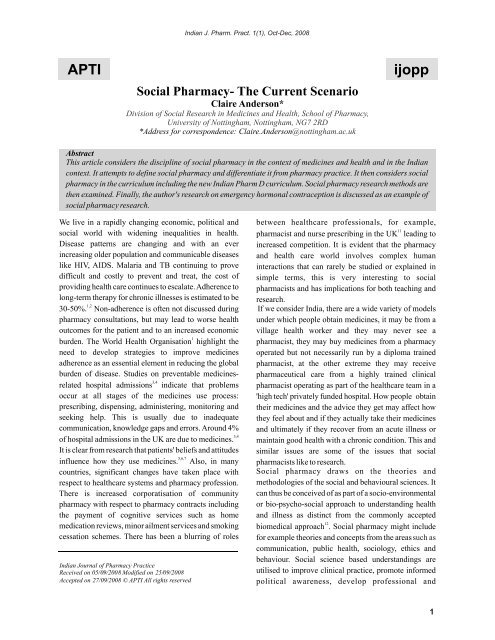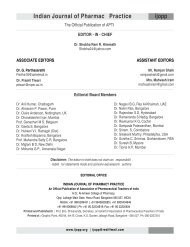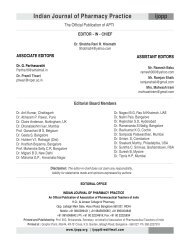APTI ijopp - Indian Journal of Pharmacy Practice
APTI ijopp - Indian Journal of Pharmacy Practice
APTI ijopp - Indian Journal of Pharmacy Practice
You also want an ePaper? Increase the reach of your titles
YUMPU automatically turns print PDFs into web optimized ePapers that Google loves.
<strong>Indian</strong> J. Pharm. Pract. 1(1), Oct-Dec, 2008<strong>APTI</strong>Social <strong>Pharmacy</strong>- The Current ScenarioClaire Anderson*Division <strong>of</strong> Social Research in Medicines and Health, School <strong>of</strong> <strong>Pharmacy</strong>,University <strong>of</strong> Nottingham, Nottingham, NG7 2RD*Address for correspondence: Claire. Anderson@nottingham.ac.uk<strong>ijopp</strong>AbstractThis article considers the discipline <strong>of</strong> social pharmacy in the context <strong>of</strong> medicines and health and in the <strong>Indian</strong>context. It attempts to define social pharmacy and differentiate it from pharmacy practice. It then considers socialpharmacy in the curriculum including the new <strong>Indian</strong> Pharm D curriculum. Social pharmacy research methods arethen examined. Finally, the author's research on emergency hormonal contraception is discussed as an example <strong>of</strong>social pharmacy research.We live in a rapidly changing economic, political and between healthcare pr<strong>of</strong>essionals, for example,social world with widening inequalities in health.11pharmacist and nurse prescribing in the UK leading toDisease patterns are changing and with an ever increased competition. It is evident that the pharmacyincreasing older population and communicable diseases and health care world involves complex humanlike HIV, AIDS. Malaria and TB continuing to prove interactions that can rarely be studied or explained indifficult and costly to prevent and treat, the cost <strong>of</strong> simple terms, this is very interesting to socialproviding health care continues to escalate. Adherence to pharmacists and has implications for both teaching andlong-term therapy for chronic illnesses is estimated to be research.1,230-50%. Non-adherence is <strong>of</strong>ten not discussed during If we consider India, there are a wide variety <strong>of</strong> modelspharmacy consultations, but may lead to worse health under which people obtain medicines, it may be from aoutcomes for the patient and to an increased economic village health worker and they may never see a1burden. The World Health Organisation highlight the pharmacist, they may buy medicines from a pharmacyneed to develop strategies to improve medicines operated but not necessarily run by a diploma trainedadherence as an essential element in reducing the global pharmacist, at the other extreme they may receiveburden <strong>of</strong> disease. Studies on preventable medicines- pharmaceutical care from a highly trained clinical3,4related hospital admissions indicate that problems pharmacist operating as part <strong>of</strong> the healthcare team in aoccur at all stages <strong>of</strong> the medicines use process: 'high tech' privately funded hospital. How people obtainprescribing, dispensing, administering, monitoring and their medicines and the advice they get may affect howseeking help. This is usually due to inadequate they feel about and if they actually take their medicinescommunication, knowledge gaps and errors. Around 4% and ultimately if they recover from an acute illness or3,4<strong>of</strong> hospital admissions in the UK are due to medicines. maintain good health with a chronic condition. This andIt is clear from research that patients' beliefs and attitudes similar issues are some <strong>of</strong> the issues that social5,6,7influence how they use medicines. Also, in many pharmacists like to research.countries, significant changes have taken place with Social pharmacy draws on the theories andrespect to healthcare systems and pharmacy pr<strong>of</strong>ession. methodologies <strong>of</strong> the social and behavioural sciences. ItThere is increased corporatisation <strong>of</strong> community can thus be conceived <strong>of</strong> as part <strong>of</strong> a socio-environmentalpharmacy with respect to pharmacy contracts including or bio-psycho-social approach to understanding healththe payment <strong>of</strong> cognitive services such as home and illness as distinct from the commonly accepted12medication reviews, minor ailment services and smoking biomedical approach . Social pharmacy might includecessation schemes. There has been a blurring <strong>of</strong> roles for example theories and concepts from the areas such ascommunication, public health, sociology, ethics andbehaviour. Social science based understandings are<strong>Indian</strong> <strong>Journal</strong> <strong>of</strong> <strong>Pharmacy</strong> <strong>Practice</strong>Received on 05/09/2008 Modified on 25/09/2008Accepted on 27/09/2008 © <strong>APTI</strong> All rights reservedutilised to improve clinical practice, promote informedpolitical awareness, develop pr<strong>of</strong>essional and1
<strong>Indian</strong> J. Pharm. Pract. 1(1), Oct-Dec, 2008managerial competencies, inform ethical judgements scientific to behavioural, being taught under the bannerand engender a critical approach which encourages <strong>of</strong> social pharmacy suggesting that there remains a lackchange and improvements in services and health care <strong>of</strong> definitional agreement.delivery.It is very interesting to note that the proposed Pharm.DThere have been several calls for a definition <strong>of</strong> social23curriculum for India does not specifically mentionpharmacy and to distinguish between social pharmacysocial pharmacy. However, the section on the internshipand pharmacy practice, but, this does not seem to have13,14,15states that an objective is “to provide patient care in cobeenachieved. Several authors have attempted tooperation with patients, prescribers, and other membersdefine social pharmacy, clinical pharmacy and pharmacy16<strong>of</strong> an inter-pr<strong>of</strong>essional health care team based uponpractice. For instance, Harding and Taylor suggest that,sound therapeutic principles and evidence-based data,in Britain, pharmacy practice provides the umbrella17under which social pharmacy exists, whereas Mounttaking into account relevant legal, ethical, social cultural,suggests that, in the US, social pharmacy (or social and economic, and pr<strong>of</strong>essional issues, emergingadministrative pharmacy) is a subset <strong>of</strong> the social technologies, and evolving biomedical, pharmaceutical,18sciences in pharmacy. Ryan and Bissell call for more social or behavioural or administrative, and clinicalapplied theoretical work in social pharmacy that could sciences that may impact therapeutic outcomes. I believehelp with the development <strong>of</strong> a theoretical and that the omission from the curriculum may prove to be aconceptual knowledge base to inform research and wasted opportunity.teaching in the discipline.Research Methods In Social <strong>Pharmacy</strong>Social <strong>Pharmacy</strong> In The <strong>Pharmacy</strong> Curriculum Social pharmacy researchers use social science researchIn 1975, in the US, the Study Commission on <strong>Pharmacy</strong> methods. These may include quantitative methods such(Millis Commission Report) identified the need toas surveys, but <strong>of</strong>ten also use qualitative researchdevelop the behavioural and social sciences in pharmacymethods like interviews, focus groups, observation,19alongside clinical practice. From 1975, the Americandocumentary analysis and conversational analysis.Council on Pharmaceutical Education includedPolicy decisions are increasingly informed by findingspharmacy administration, social and behaviouralfrom qualitative as well as quantitative research.sciences in their indicative curriculum. The most recenteducational statement from the American Association <strong>of</strong>Qualitative research is useful to policy makers because itColleges <strong>of</strong> <strong>Pharmacy</strong> incorporates many social and <strong>of</strong>ten describes the settings in which policies will bebehavioural topics as required outcomes <strong>of</strong> pharmacy implemented. Qualitative research is also useful to20programmes in the US. A number <strong>of</strong> European countries pharmacy practitioners as they develop their services.introduced social pharmacy into their curricula in the Qualitative research involves the collection, analysis andmid-1970's. In the UK, in 1986, the Nuffield Committee interpretation <strong>of</strong> data that are not easily reduced to21<strong>of</strong> inquiry into <strong>Pharmacy</strong> declared that behavioural numbers. These data relate to the social world and thescience should be incorporated into the undergraduate concepts and behaviours <strong>of</strong> people within it. Qualitativepharmacy curriculum. This was endorsed by the Royal research can be found in all social sciences and in thePharmaceutical Society (RPSGB) Working Party on24applied fields that derive from them. It looks at what is22Social and Behavioural Science. Teaching <strong>of</strong> social X, how does X vary? in different circumstances ratherpharmacy is now undertaken in all UK schools <strong>of</strong>25than how big is X or how many Xs are there. Text-bookspharmacy in the UK and forms part <strong>of</strong> the RPSGB's<strong>of</strong>ten sub-divide research into qualitative and12indicative curriculum. In our recent survey , we used aquantitative approaches and it is <strong>of</strong>ten assumed that thereweb-based questionnaire to collect data on social scienceare fundamental differences between the twoteaching in schools <strong>of</strong> <strong>Pharmacy</strong>. There were 62responses representing schools <strong>of</strong> pharmacy from 17approaches. With pharmacist’s who have been trained incountries. The social science disciplines appear to have the natural and clinical sciences, there is <strong>of</strong>ten a tendencygained in acceptance within the pharmacy establishment To embrace quantitative research, perhaps due toshowing an advancing degree <strong>of</strong> sophistication and familiarity. However, a growing consensus is emergingrudimentary development <strong>of</strong> a theoretical base. which sees both qualitative and quantitative approachesHowever, there was a wide range <strong>of</strong> subjects, from as useful to answering research questions and2
<strong>Indian</strong> J. Pharm. Pract. 1(1), Oct-Dec, 2008understanding the world. Increasingly mixed methods about long-term contraception needs and sexually26research is being carried out where quantitative and transmitted infections in the context <strong>of</strong> the consultation.qualitative research are used together in the same study Some felt that the service should be confined toand the researcher explicitly combines the quantitative supplying emergency contraception rather thanand qualitative aspects <strong>of</strong> the study to both develop and counseling individuals on their long-term contraceptiontest theories.needs or the risks <strong>of</strong> sexually transmitted infections. In-An Example <strong>of</strong> Social <strong>Pharmacy</strong> Research ondepth interviews with pharmacists indicated that havingEmergency Hormonal ContraceptionOne <strong>of</strong> the projects that I have been involved was the a ten minute private consultation with women hadevaluation <strong>of</strong> the two initial schemes for pharmacy changed women's perceptions <strong>of</strong> pharmacists, andsupply <strong>of</strong> emergency hormonal contraception possibly increased their pr<strong>of</strong>essional status in the eyes <strong>of</strong>27,28,29(EHC). I worked alongside a social scientist on this users. We have tried to seek an explanation for whyproject. There was considerable political concern about pharmacists welcomed the scheme and also had strongthese government funded schemes aimed at reducing reservations about it. Their positive attitudes towards theteenage pregnancy levels. However, in keeping with my scheme may be a reflection <strong>of</strong> their desire to welcomebelief that pharmacies could be a unique forum for and show competence in the delivery <strong>of</strong> new andimproving access to services, I immediately saw these innovative roles, important for the future development <strong>of</strong>schemes as setting down a marker for pharmacists' the pr<strong>of</strong>ession. We showed that providing a service whichinvolvement in other areas <strong>of</strong> practice development and involved conducting a detailed and private consultationpublic health. We used interviews with pharmacists andwith women (and then supplying a product free <strong>of</strong>stakeholders, surveys and focus groups with women andcharge) was considered to be different to other servicesa form <strong>of</strong> participant observation, mystery shopping tocurrently provided within community pharmacy. Notevaluate the services. Our evaluation <strong>of</strong> these schemesonly did many pharmacists enjoy these aspects <strong>of</strong>indicated that pharmacists were enthusiastic about thispractice, they also received remuneration for it withoutrole and that they supply emergency contraceptionhaving to charge for the service. More than oneappropriately. Surveys with 745 women who had usedthe service indicated that they viewed the serviceparticipant argued that this potentially paved the way forpositively. However, 15 percent <strong>of</strong> those surveyed, the future delivery <strong>of</strong> other services, for examplemainly those who were under 20 years, would prefer pharmacist prescribing and new funding streams. Othersmore privacy- something pharmacists have subsequently believed that the service had changed public perceptionsaddressed with the provision <strong>of</strong> consultation areas. <strong>of</strong> pharmacists, and this potentially enhanced theirMajority <strong>of</strong> the women who used the service were not pr<strong>of</strong>essional status. These factors are likely to beteenagers. Our findings also demonstrated that the important to pharmacists, given the need to develop newincreased access to emergency contraception via roles and responsibilities in response to the historicalpharmacy means that it is more likely that women are threats to their pr<strong>of</strong>essional legitimacy. Edmunds andable to take emergency contraception sooner after30Calman have argued that the development <strong>of</strong> new rolesunprotected intercourse than when they obtain it fromand responsibilities is essential for pharmacy as aother sources. The largest number <strong>of</strong> consultations was atsurvival strategy. It is possible that pharmacists' attitudesweekends or on Monday mornings when other servicesto the schemes, at least to some extent, reflect these widerare difficult to access. In particular, the women surveyedpr<strong>of</strong>essional necessities. What we do not know is that thenoted a welcome absence <strong>of</strong> judgmental attitudes whensupply <strong>of</strong> EHC via pharmacyhas met the policy objectiveaccessing the service. However, both the women usingthe schemes and the pharmacists had a number <strong>of</strong> major<strong>of</strong> reducing teenage pregnancy in women from lowerconcerns about the schemes, centering on the potentialsocio economic groups, many <strong>of</strong> the users were olderfor misuse, changes in contraceptive behaviour due to the women. However, our research has helped in theavailability <strong>of</strong> EHC and the impact on sexually continued funding <strong>of</strong> these services and informed manytransmitted infections. More research is needed to primary care organisations in the UK who set up similarexplore these issues. A number <strong>of</strong> participants questionedservices for supply <strong>of</strong> EHC and Chlamydia screening andthe wisdom <strong>of</strong> the pharmacist providing advice treatmentservices.3
<strong>Indian</strong> J. Pharm. Pract. 1(1), Oct-Dec, 200825. Pope C, Mays N. Qualitative Research in Healthcare.rd3 ed Blackwell Publishing, Oxford 2006.26. Creswell J Creswell, John W Plano Clark, VickiL Designing and Conducting Mixed MethodsResearch Sage , CA , 2006.27. Bissell P, Anderson C Supplying emergencycontraception via community pharmacies in the UK:reflections on the experience <strong>of</strong> providers and users.Soc Sci Med 2003; 57: 2367-2378.28. Bissell P, Savage I, Anderson C. A qualitative study<strong>of</strong> pharmacists' perspectives on the supply <strong>of</strong>emergency hormonal contraception via patientgroup direction in the UK. Contraception 2006; 73:265-270.29. Anderson C, Bissell P Using semi covert research toevaluate an emergency hormonal contraceptionservice. Pharm World Sci 2004; 26:102-106.30. Edmunds J, Calnan, M. The repr<strong>of</strong>essionalisa-tion<strong>of</strong> community pharmacy? An exploration <strong>of</strong>attitudes to extended roles for communitypharmacists by pharmacists and generalpractitioners in the UK. Social Science & Medicine,2001; 53: 943-955.5
















